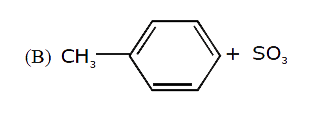Which of the followig substances yeild less than 4 Kcal/mol when its phosphate bond is hydrolysed
Creatine phosphate
ADP
Glucose-6-phosphate
ATP
The correct Answer is:C
Step by step video, text & image solution for Which of the followig substances yeild less than 4 Kcal/mol when its phosphate bond is hydrolysed by Biology experts to help you in doubts & scoring excellent marks in Class 11 exams.
Topper's Solved these Questions
Similar Questions
Knowledge Check
- Question 1 - Select One
Which of the following is obtained when 4- Methylbenzenesulphonic acid is hydrolysed with excess of sodium acetate?
A B
B C
C D
D
- Question 2 - Select One or More
Which of the followig sepcies has less number of protons than the number of neutrons?
A.126CB.199FC.2311NaD.2412Mg - Question 3 - Select One
Heat of neutralisation is less than 13.7 kcal/mol for the reaction
AHCl+NaOH→NaCl+H2OBH2SO4+2NaOH→Na2SO4+2H2OCHNO3+NaOH→NaNO3+H2ODCH3COOH+NaOH→CH3COONa+H2O
In which of the following case (s) least one bond angle is less than 90∘?
View SolutionWhich of the following bonds has the highest bond energy?
View SolutionWhich of the following are true statements?
I. The heat capacity of a substance is the amount of heat that substance can hold per unit of temperature.
II. The specic heat for a single substance is the same for all phases of that substance.
III. When heat is added to a fluid, its temperature will change less if it is allowed to expand.View SolutionWhich of the following statements are correct?
1. A σ bond is stronger than a π bond
2. A covalent bond is stronger than a hydrrogen bond
3. HF is more polar than HCl
4. There is one electrovalent bond and three covalent bonds in methylene chloride Select the correct answer using the codes given belowView SolutionThe hydrogen bond is an electrostatic attractive force between covalently bonded hydrogen atom of one molecule and an electronegative atom like (F,O,N) of other molecule. Hydrogen bond is nearly an electrostatic attractive force and not a normal chemical bond. It is very weak (2-10 kcal/mol) as compared to a colvent bond (strength 50-100 kcal/mol). In intramolecular hydrogen bonding, the two or more than two molecules of the same or different substances are linked to form polymeric aggregate. Intermolecular hydrogen bonding increases the boiling point of the compound and also its solubility in water. Intramolecular hydrogen bonding occurs within two atoms of the same molecule. Intramolecular hydrogen bonding is also called chelation, since it involves ring formation. intramolecular hydrogen bonding decreases the boiling point of the compound and also its solubility in water.
Which of the following molecules is dimerised when dissolved in non-polar or organic solvent?View Solution

